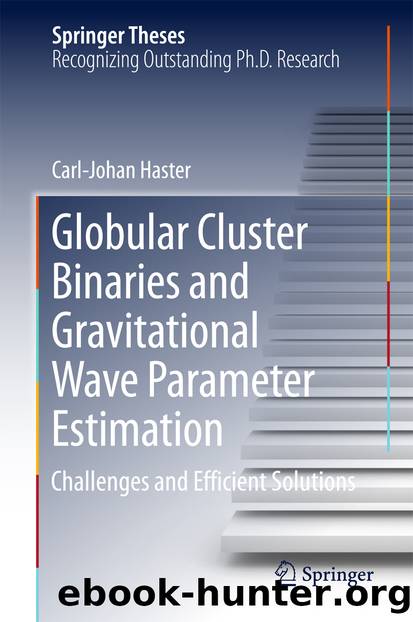Globular Cluster Binaries and Gravitational Wave Parameter Estimation by Carl-Johan Haster

Author:Carl-Johan Haster
Language: eng
Format: epub
Publisher: Springer International Publishing, Cham
The top panel of Fig. 2.7 shows the horizon distance , which is the luminosity distance at which GWs from a face-on overhead binary would be detected at a signal-to-noise ratio of 8 by a single detector with the sensitivity of Advanced LIGO; the corresponding horizon redshift is shown on the right vertical axis. This signal-to-noise ratio is used as an approximation for sensitivity by the full network [3, 6]; the actual sensitivity depends on the network configuration, data quality, and signal duration. We use the noise power spectral density (PSD) of H1 (the LIGO detector in Hanford, WA) during the S6 science run (curve labeled â2010â, [47]), the measured noise PSD of H1 during the 2015 observing run O1 (â2015â2016â, [48]), low-end predictions for Advanced LIGO noise PSD for the later stages of detector commissioning (â2017â2018â, O3 configuration of [7]), and for design sensitivity runs in the zero detuning, high laser power configuration (â2019+â, [46]). We use circular effective one-body waveforms calibrated to numerical relativity for signal-to-noise-ratio calculations [79].
The bottom panel of Fig. 2.7 shows the surveyed detection-weighted comoving volume
Download
This site does not store any files on its server. We only index and link to content provided by other sites. Please contact the content providers to delete copyright contents if any and email us, we'll remove relevant links or contents immediately.
Learning SQL by Alan Beaulieu(6213)
Weapons of Math Destruction by Cathy O'Neil(6151)
Digital Minimalism by Cal Newport;(5667)
iGen by Jean M. Twenge(5367)
Sapiens by Yuval Noah Harari(5295)
The Age of Surveillance Capitalism by Shoshana Zuboff(4216)
Elon Musk by Ashlee Vance(4033)
Thing Explainer by Randall Munroe(3877)
Apollo 8 by Jeffrey Kluger(3638)
Future Crimes by Marc Goodman(3534)
The Science Book (Big Ideas Simply Explained) by DK(3233)
Who Can You Trust? by Rachel Botsman(3089)
Infinite Energy Technologies by Finley Eversole(2939)
I Live in the Future & Here's How It Works by Nick Bilton(2938)
The Innovators: How a Group of Hackers, Geniuses, and Geeks Created the Digital Revolution by Walter Isaacson(2849)
Steve Jobs by Walter Isaacson(2837)
Dawn of the New Everything by Jaron Lanier(2738)
Chernobyl by Serhii Plokhy(2499)
Ben Franklin's Almanac by Candace Fleming(2470)
